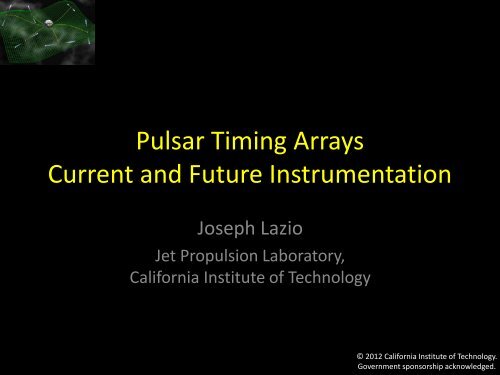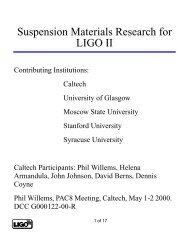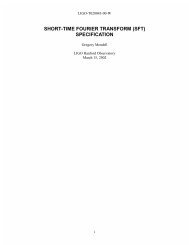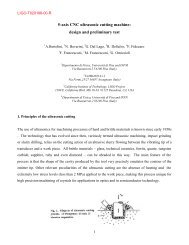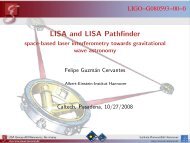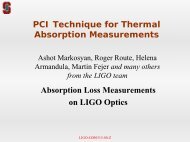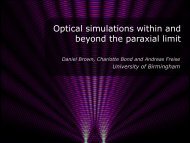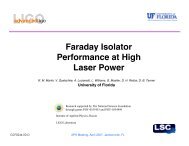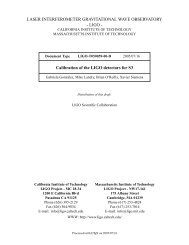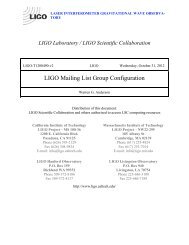Pulsar Timing Arrays Current and Future Instrumentation - DCC
Pulsar Timing Arrays Current and Future Instrumentation - DCC
Pulsar Timing Arrays Current and Future Instrumentation - DCC
You also want an ePaper? Increase the reach of your titles
YUMPU automatically turns print PDFs into web optimized ePapers that Google loves.
<strong>Pulsar</strong> <strong>Timing</strong> <strong>Arrays</strong><strong>Current</strong> <strong>and</strong> <strong>Future</strong> <strong>Instrumentation</strong>Joseph LazioJet Propulsion Laboratory,California Institute of Technology© 2012 California Institute of Technology.Government sponsorship acknowledged.
• What are therequirements?<strong>Pulsar</strong> <strong>Timing</strong> <strong>Arrays</strong><strong>Current</strong> <strong>and</strong> <strong>Future</strong> <strong>Instrumentation</strong><strong>Timing</strong> precision <strong>and</strong>instrumental performance• What exists?TelescopesFeeds, receivers, <strong>and</strong>backendsIT infrastructure• What is on the horizon?
<strong>Pulsar</strong> <strong>Timing</strong> <strong>Arrays</strong><strong>Current</strong> ResultsJ1713+074730 ns RMSJ1012+5307280 ns RMSJ1643-12241500 ns RMSDemorest et al. 2012, submitted
<strong>Timing</strong> Precision• Assume σ TOA ≤ 100 nsMay be necessary, but not sufficientconditionWSNRPσ TOA, n=WSNR• W pulse width• SNR signal-to-noise ratio• Assumes sufficient calibration oftelescope systemOther contributions can include pulse-phasejitter, uncorrected propagation effects
Radio Telescope
Radio TelescopeRadioFrequencyDataAcquisitionSystemDataStorageIntermediate FrequencyBaseb<strong>and</strong>LocalOscillatorLocalOscillator
Radio TelescopeTNoise Temperature• Replace entire telescopesystem by resistor in a heatbath• Output voltage equivalent• Not necessarily physicaltemperature• T sys = T sky + T spill + T Rx + …• P = k B T∆ν
Radiometer EquationFor T PSR
<strong>Pulsar</strong> ObservationsObservational frequencydetermined by balancing• pulsar spectrum vs.•sky spectrum vs.•scattering<strong>Pulsar</strong>spectrumscatteringTypically about 1 GHzsky spectrum
<strong>Pulsar</strong> <strong>Timing</strong> <strong>Arrays</strong><strong>Current</strong> <strong>Instrumentation</strong>
<strong>Pulsar</strong> <strong>Timing</strong> <strong>Arrays</strong><strong>Current</strong> <strong>Instrumentation</strong>Discovery of millisecondpulsars (MSPs)Robert C. Byrd Green BankTelescope (GBT) dedicated
<strong>Pulsar</strong> <strong>Timing</strong>Historical Context• 1974: Hulse-Taylor binary pulsar– Arecibo telescope @ 430 MHz– ≤ 8 MHz b<strong>and</strong>width– 175 K system temperatureT sky = 25 K @ 430 MHz• 1982: first millisecond pulsar (B1937+21)– Arecibo telescope @ 1400 MHz– 16 MHz b<strong>and</strong>width– 40 K system temperatureT sky ~ 7 K @ 1400 MHz
<strong>Pulsar</strong> <strong>Timing</strong> <strong>Arrays</strong><strong>Current</strong> <strong>Instrumentation</strong>Typical Parameters• A eff ~ 100 m• ∆ν ~ 100 MHz• T sys ~ 30 K• ∆t ~ 15 min.<strong>Current</strong> Publications• Yardley et al. 2011, “On detection of thestochastic gravitational-wave background usingthe Parkes pulsar timing array,” Mon. Not. R.Astron. Soc., 414, 1777• van Haasteren et al. 2011, “Placing limits on thestochastic gravitational-wave background usingEuropean <strong>Pulsar</strong> <strong>Timing</strong> Array data,” Mon. Not.R. Astron. Soc., 414, 3117• Demorest et al. 2012, “Limits on the StochasticGravitational Wave Background from the NorthAmerican Nanohertz Observatory forGravitational Waves,” ApJ, in press• Hobbs et al. 2010, “The International <strong>Pulsar</strong><strong>Timing</strong> Array project: using pulsars as agravitational wave detector,” Class. Quant.Grav., 27, 084013
<strong>Pulsar</strong> <strong>Timing</strong> <strong>Arrays</strong>Near <strong>Future</strong><strong>Instrumentation</strong>Receiver performancereaching fundamentallimits, e.g.,• T sys ≈ 20 K• ∆ν ~ 1 GHz forobservations near 1 GHzNew <strong>Pulsar</strong>s• Major radio pulsarsurveys worldwide– HTRU (Parkes)– GBNCC (GBT)– GBT drift scan (GBT)– P-ALFA (Arecibo)• Multi-wavelength MSPsa.k.a. Fermi
<strong>Pulsar</strong> Surveysa “position” on the sky• New pulsars– Add more arms to PTA,increase sensitivity; or– For fixed amount ofobserving time, improvequality of PTA• Survey algorithm1. Observe position on sky2. Search resulting timeseries for periodic signal atperiod P with dispersionDM, with orbitalparameters– Loop
<strong>Pulsar</strong> <strong>Timing</strong> <strong>Arrays</strong>Near <strong>Future</strong>
Green Bank Ultimate <strong>Pulsar</strong>Processing Instrument(GUPPI)• BEE2 feeds 8 gamingsystems w/NVIDIA GPUs• 100, 200, or 800 MHzb<strong>and</strong>width• Large improvement intiming precision• ~1 TFLOP in real time• operational<strong>Pulsar</strong> <strong>Timing</strong> <strong>Arrays</strong>Digital Backends
<strong>Pulsar</strong> <strong>Timing</strong> <strong>Arrays</strong>Digital BackendsWide-b<strong>and</strong>width (1+ GHz),real-time systemsimplementing RFImitigation <strong>and</strong> folding(in construction)• Parkes HIPSR• Effelsberg ASTERIX <strong>and</strong>follow-on• Arecibo PUPPIClone of GBT GUPPIFPGA-based Reconfigurable Open Architecture ComputingHardware (ROACH), developed by Center for AstronomicalSignal Processing <strong>and</strong> Electronics Research (CASPER, at UCBerkeley)
<strong>Pulsar</strong> <strong>Timing</strong> <strong>Arrays</strong>New Feed & Rx Systems• GBT Wide-B<strong>and</strong> <strong>Pulsar</strong>System• Arecibo Wide-B<strong>and</strong> System• Effelsberg Ultra-broad B<strong>and</strong>• Arecibo AO40• Five-hundred metreAperture SphericalTelescope (FAST) multi-feedsystem19 or 100 feed hornsT sys ~ 29K (5K sky + 9K spill + 4K coax jct + 7K dewar jct + 3K LNA)
<strong>Pulsar</strong> <strong>Timing</strong> <strong>Arrays</strong>New Feed & Rx Systems• GBT Wide-B<strong>and</strong> <strong>Pulsar</strong>System• Arecibo Wide-B<strong>and</strong>System• Effelsberg Ultra-broad B<strong>and</strong>• Arecibo AO40• Five-hundred metreAperture SphericalTelescope (FAST) multi-feedsystem19 or 100 feed hornsQuasi Self-Complementary Feed(developed under U.S. SKA auspices)
<strong>Pulsar</strong> <strong>Timing</strong> <strong>Arrays</strong>New ApproachesSRT, Sardinia, ItalyEffelsberg 100-m, GermanyThe European<strong>Pulsar</strong> <strong>Timing</strong>Array (EPTA):100-m classtelescopesNRT, Nancay, FranceWSRT, Westerbork, NLLovell, Jodrell Bank,UKUltimately forming the Large European Array for <strong>Pulsar</strong>s (LEAP)
Large European Array for <strong>Pulsar</strong>s = LEAP!<strong>Current</strong> status:<strong>Pulsar</strong> <strong>Timing</strong> <strong>Arrays</strong>New Approaches- Hardware to record >128 MHz BW, 8 bits, baseb<strong>and</strong> data inplace at all telescopes:ASTERIX-like systems at Effelsberg <strong>and</strong> Jodrell BankPUMA-II at WesterborkBON at NançayDFB (in APSR-mode, to be tested) at Sardinia- 24 hr observations at L-b<strong>and</strong>, once per month (in additionto regular EPTA observations – 30 TB/site/session)- Data currently shipped by disk, internet tested- Successful addition of EFF-JB-WSRT,Nançay added within days/week, SRT in Q4/2012Almost there: 160-m dish!Only 10-sec of data:
<strong>Pulsar</strong> <strong>Timing</strong> <strong>Arrays</strong>New ApproachesFor a set of N telescopes <strong>and</strong> M pulsars, what is the optimal schedulingthat maximizes the probability of detecting gravitational waves?Telescope Infrastructure<strong>Pulsar</strong> Sample
<strong>Pulsar</strong> <strong>Timing</strong> <strong>Arrays</strong><strong>Future</strong> TelescopesKarl G. Jansky Very Large ArrayFive-hundred metre ApertureSpherical Telescope (FAST)• A eff ~ 130 m• YUPPI backendClone of GUPPI, implemented in existingcorrelator• Primarily a timing instrument• D eff ~ 300 m• 19 or 100-beam system• ~ 500 new MSPs discovered (projected)
<strong>Pulsar</strong> <strong>Timing</strong> <strong>Arrays</strong><strong>Future</strong> TelescopesAustralian Square KilometreArray Pathfinder (ASKAP)Karoo Array Telescope(MeerKAT)• A eff ~ 60 m• Phased array feed ~ 30 deg 2 field ofview• Primarily a search instrument• A eff ~ 100 m• Primarily a timing instrument
Square Kilometre ArrayThe Global Radio Wavelength Observatory• Originally: “Hydrogen telescope”Detect H I 21-cm emission from MilkyWay-like galaxy at z ~ 1• SKA science much broader⇒ Multi-wavelength, multimessenger• On-going technical development• International involvement
Radio Telescopes <strong>and</strong>Astrophysical SourcesSearch for additional dual SMBHs,progenitors of GW-emitting binary SMBHs• With VLBA now, SKA in the future• Relevant for future space-based GWmission7 pcB0402+679Very Long Baseline Array (VLBA)
• What are therequirements?<strong>Pulsar</strong> <strong>Timing</strong> <strong>Arrays</strong><strong>Current</strong> <strong>and</strong> <strong>Future</strong> <strong>Instrumentation</strong>‣ Instrumental performanceimproving steadily• What exists?‣ Powerful set of telescopes• What is on the horizon?‣ Increasing capabilitywith new telescopes


